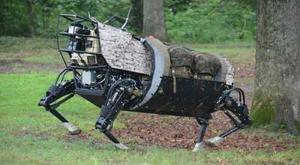In the trenchesFour-legged robotic mule now voice-controlled
DARPA researchers demonstrated new advances in the Legged Squad Support System (LS3) four-legged robot’s control, stability, and maneuverability, including “Leader Follow” decision making, enhanced roll recovery, exact foot placement over rough terrain, the ability to maneuver in an urban environment, and verbal command capability

Big Dog four-legged baggage carrier now takes voice commands // Source: darpa.mil
For the weeks before the holiday, in the woods of central Virginia around Fort Pickett, the Legged Squad Support System (LS3) four-legged robot has been showing off its capabilities during field testing.
Working with the Marine Corps Warfighting Laboratory (MCWL), researchers from DARPA’s LS3 program demonstrated new advances in the robot’s control, stability, and maneuverability, including “Leader Follow” decision making, enhanced roll recovery, exact foot placement over rough terrain, the ability to maneuver in an urban environment, and verbal command capability.
A DARPA release reports that the LS3 program seeks to demonstrate that a highly mobile, semi-autonomous legged robot can carry 400 lbs of a squad’s equipment, follow squad members through rugged terrain, and interact with troops in a natural way similar to a trained animal with its handler. The robot could also be able to maneuver at night and serve as a mobile auxiliary power source to the squad, so troops can recharge batteries for radios and handheld devices while on patrol.
“This was the first time DARPA and MCWL were able to get LS3 out on the testing grounds together to simulate military-relevant training conditions,” said Lt. Col. Joseph Hitt, DARPA program manager.
“The robot’s performance in the field expanded on our expectations, demonstrating, for example, how voice commands and “follow the leader” capability would enhance the robot’s ability to interact with warfighters. We were able to put the robot through difficult natural terrain and test its ability to right itself with minimal interaction from humans.”
Video from the testing shows the robot negotiating diverse terrain including ditches, streams, wooded slopes and simulated urban environments. The video also shows the map the LS3 perception system creates to determine the path it takes.
The December testing at Fort Pickett is the first in a series of planned demonstrations that will test the robot’s capabilities across different environments as development continues through the first half of 2014.
The DARPA platform developer for the LS3 system is Boston Dynamics of Waltham, Massachusetts.
